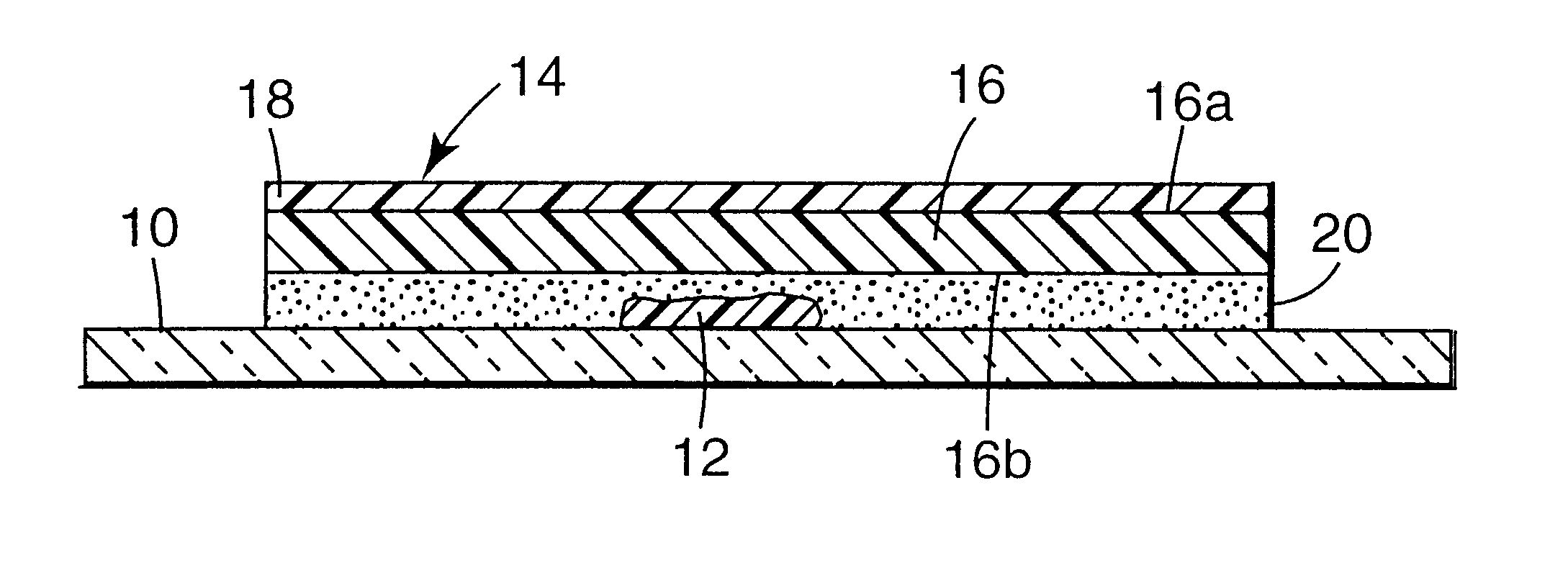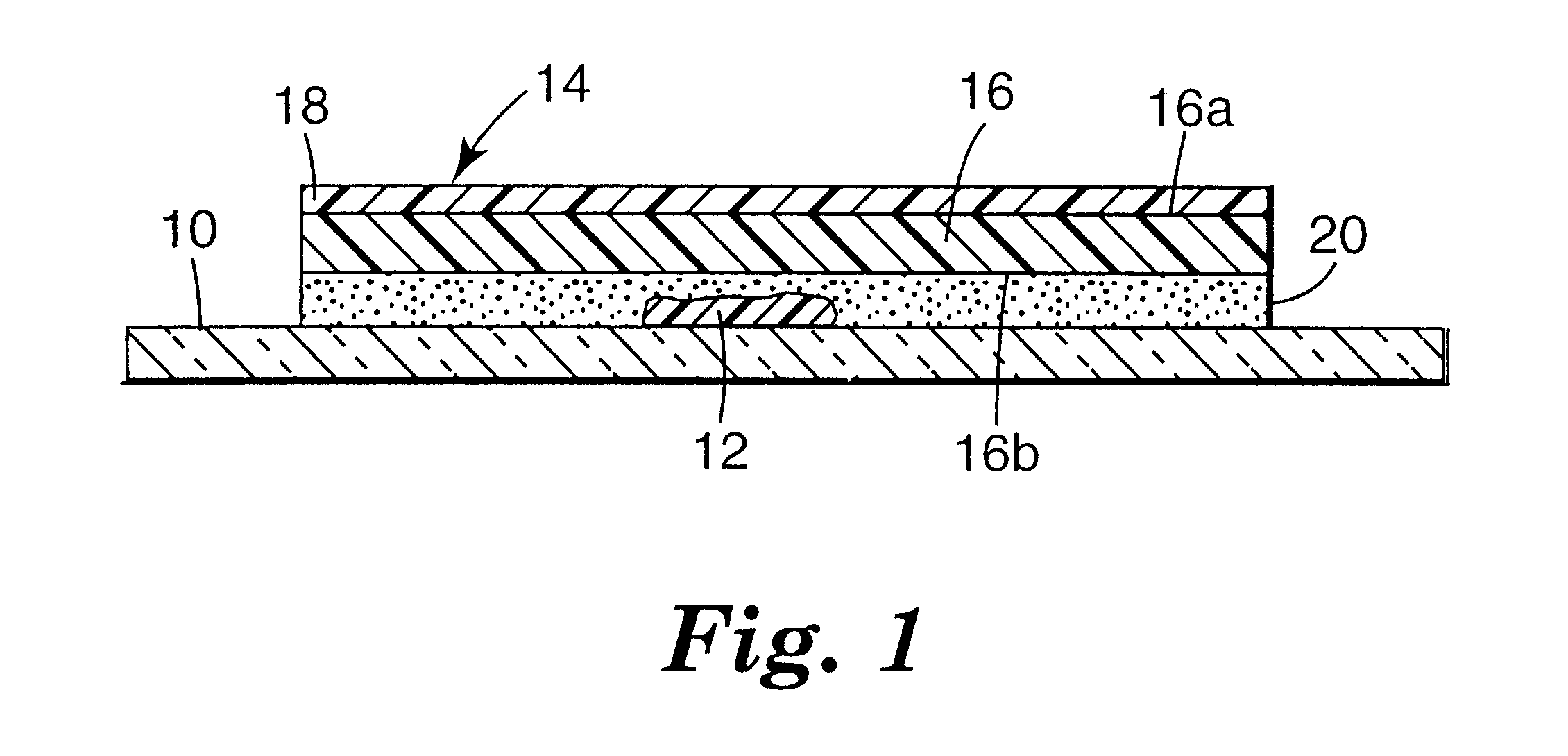Microscope cover slip materials
a technology for microscopes and covers, applied in the field of new and improved cover slip materials, can solve the problems of inability to preserve specimens, damage specimens, injuring users, etc., and achieve the effects of reducing health hazards, good flexibility, and sufficient processing strength
- Summary
- Abstract
- Description
- Claims
- Application Information
AI Technical Summary
Benefits of technology
Problems solved by technology
Method used
Image
Examples
examples 1 to 15
These Examples show the components of various protective coatings formulations. In Table 1 below, the components used to make the coatings are categorized. Within each category, the amount and type of material are listed. For example, "DMS-S12" is silanol terminated polydimethylsiloxane, "SIB 1824" is 1,8-bistriethoxysilyl octane, "TESPA" is 3-triethoxysilylpropyl acrylate, "RC 706," "RC 726", "RC 711," and "RC 902" are silicone acrylates, "SIT 8175" is tridecafluorooctyltriethoxysilane, "RHODOSIL" is RHODOSIL 2074--a photoacid, "DAROCURE" is DAROCURE 1173--a photo radical initiator, "DPTMBPO" is diphenyl trimethylbenzoyl phosphine oxide, and "IPA" is isopropanol.
The components listed in each Example were charged and mixed in a vessel. The mixture was coated on a PMMA backing, dried for about 2 minutes in a 70.degree. C. (158.degree. F.) oven, then cured in a nitrogen filled chamber equipped with an ultraviolet lamp unit containing a UV processor with a P300 power supply, and H bulb...
example 16 to 17
These Examples show protective coatings containing perfluorooctyl acrylate.
In Example 16, 1 g ceramer solution, 0.1 g 1H, 1H-dihydroperfluorooctyl acrylate, 0.04 g DAROCURE 1173, and 10 g IPA were charged and mixed in a vessel. The resulting mixture was coated onto oriented PMMA from 3M using a Meyer rod. The coating was dried and cured as in Example 1, using a UV dosage of about 40 mJ / cm.sup.2.
In Example 17, 1 g ceramer solution, 0.0 g RC 711, 0.05 g 1H, 1H-perfluorooctyl acrylate, 0.04 g DAROCURE 1173, and 10 g IPA were charged and mixed in a vessel. The resulting mixture was coated onto oriented PMMA from 3M using a Meyer rod. The coating was dried and cured as in Example 1, using a UV dosage of about 40 mJ / cm.sup.2.
examples 18 to 21
The following Examples show the various bonding layers made by solution polymerization.
The components listed in each Example in the amount listed in Table 2, along with 150 g ethyl acetate and 0.125 g 2,2'-azobisisobutyronitrile, were charged into glass bottles. The bottles were capped and placed for about 21 hours in a 60.degree. C. (140.degree. F.) water bath equipped with agitation to yield various copolymer solutions. Using a knife coater, the solutions were coated on 100 micrometer thick polyester terephthalate film coated with polyvinylidene chloride latex primer. The coated solution was dried for about 10 minutes in a 65.degree. C. oven to yield a cover slip having a bonding layer dry thickness of about 30 micrometers. The cover slip material was subjected to tack, adhesion to glass, and accelerated testing.
In Table 2 below, the components listed include alkyl acrylates, such as 2-ethylhexyl acrylate (2-EHA), isobornyl acrylate (IBOA), t-butyl acrylate (t-BA), and n-butyl acr...
PUM
| Property | Measurement | Unit |
|---|---|---|
| weight ratio | aaaaa | aaaaa |
| refractive index | aaaaa | aaaaa |
| Tg | aaaaa | aaaaa |
Abstract
Description
Claims
Application Information
 Login to View More
Login to View More - R&D
- Intellectual Property
- Life Sciences
- Materials
- Tech Scout
- Unparalleled Data Quality
- Higher Quality Content
- 60% Fewer Hallucinations
Browse by: Latest US Patents, China's latest patents, Technical Efficacy Thesaurus, Application Domain, Technology Topic, Popular Technical Reports.
© 2025 PatSnap. All rights reserved.Legal|Privacy policy|Modern Slavery Act Transparency Statement|Sitemap|About US| Contact US: help@patsnap.com


